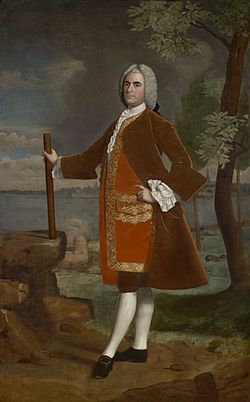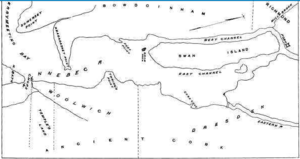Northeast Coast campaign (1745) facts for kids
Quick facts for kids Northeast Coast campaign (1745) |
|||||||
|---|---|---|---|---|---|---|---|
| Part of King George's War | |||||||
 Commander Samuel Waldo |
|||||||
|
|||||||
| Belligerents | |||||||
Wabanaki Confederacy |
|||||||
| Commanders and leaders | |||||||
| Commander Samuel Waldo (Falmouth) Captain Jonathan Bean Captain Mochus Captain Thomas Bradbury (Saco) Jabez Bradbury (Fort St. George, Thomaston) |
Colonel Morris † Captain Sam † Colonel Job |
||||||
| Strength | |||||||
| 625 | unknown |
||||||
| Casualties and losses | |||||||
| approximately 30 persons killed or captured | unknown | ||||||
The Northeast Coast campaign (1745) was a series of attacks that happened during King George's War. It took place from July 19 to September 5, 1745. Just three weeks after the British captured Louisbourg in Canada, the Wabanaki Confederacy decided to strike back.
They attacked settlements in New England along the coast of what is now Maine. These attacks happened between the towns of Berwick and St. Georges. Within two months, there were 11 raids. Almost every town on the frontier was attacked. The main settlement was Casco, also known as Falmouth or Portland.
Why the Campaign Happened
After two attacks on Annapolis Royal in 1744, Governor William Shirley of Massachusetts offered a reward. This reward was for capturing or harming members of the Passamaquoddy, Mi’kmaq, and Maliseet tribes. This happened on October 20. The next year, on August 23, 1745, Governor Shirley declared war. This time, he declared war against the Penobscot and Kennebec tribes, who were also part of the Wabanaki Confederacy.
The Wabanaki Confederacy attacked the New England border. This was their response to New England's successful attack on Louisbourg in June 1745. New England had prepared for such attacks. They had a special force of 450 soldiers ready to defend their border. After the attacks started, they added 175 more soldiers. Massachusetts also built forts along the border with Acadia. These included Fort George at Brunswick (built in 1715), St. George's Fort at Thomaston (built in 1720), and Fort Richmond (built in 1721) at Richmond. Another fort, Fort Frederick, was built at Pemaquid (now Bristol, Maine).
Key Events of the Campaign
The campaign began on July 19. Mi’kmaq people from Nova Scotia, along with Maliseet and some from St. Francois, attacked Fort St. George in Thomaston and the town of New Castle. They set many buildings on fire. They also harmed cattle and took one villager captive. On the same day, a person lost their life in Saco.
At the same time, Penobscot and Norridgewock people attacked Fort Frederick at Pemaquid. They captured a woman, which worried the soldiers. However, she managed to escape. In the same month, a boy died in Topsham and a man in New Meadows.
Later that month, 30 Wabanaki warriors attacked North Yarmouth. A man died during this attack. At Flying-point, three members of a family lost their lives. Their daughter was taken prisoner to Canada. During this raid, another man died, one was captured, and one managed to escape.
The St. George's garrison in Thomaston was attacked again. A company of soldiers was lost, and three other men were taken captive. Near the garrison, two women were captured. One was taken to Canada, while the other escaped. The attackers then moved to Scarborough, where one man died. After that, they attacked Sheepscot, where two people died and one was injured. On September 5, tribes from the Confederacy attacked Thomaston (St. Georges) for the third time. Two people were attacked and harmed during this raid.
What Happened Next
After these events, Governor Shirley sent more soldiers and supplies to the Maine frontier. He expected more attacks from the Wabanaki during the spring of 1746. There were nine raids in the campaign of 1746. Then, 12 more raids happened in the Northeast Coast campaign of 1747.


